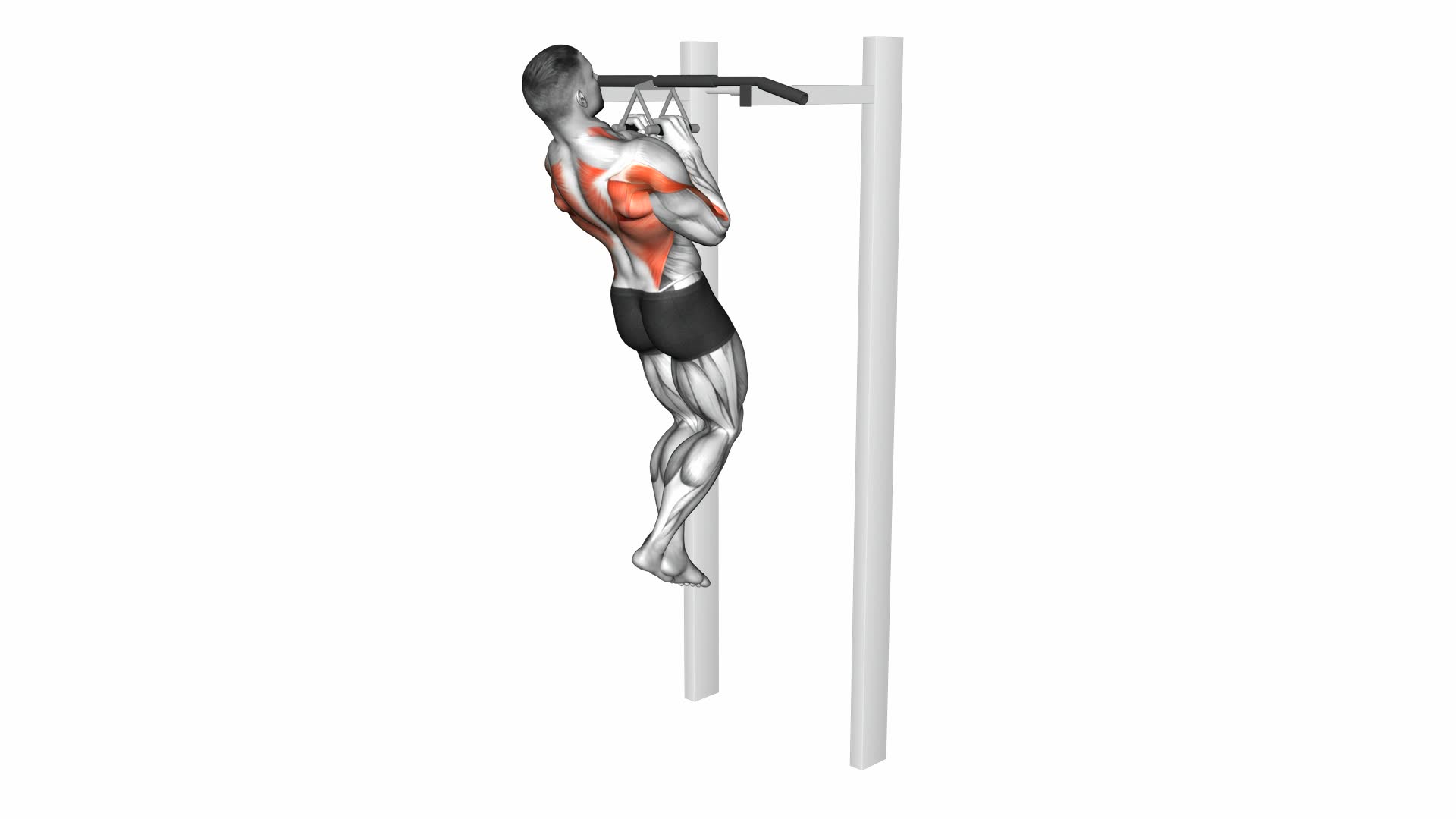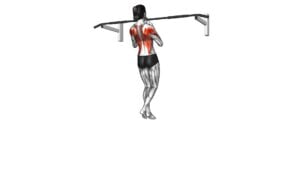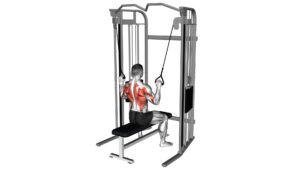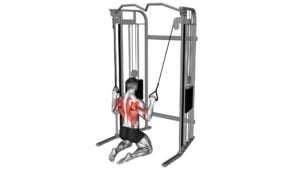Chin-Ups (Narrow Parallel Grip) – Video Exercise Guide & Tips

Looking to strengthen your upper body?
Watch This Exercise Video
Check out this video exercise guide and tips for chin-ups with a narrow parallel grip.
Learn the proper technique, common mistakes to avoid, progressions and variations, as well as tips for increasing strength and reps.
With safety considerations in mind, this informative guide will help you achieve the most from your chin-up workouts.
Get ready to take your upper body strength to new heights!
Key Takeaways
- Chin-ups with a narrow parallel grip increase muscle activation in the upper body.
- They target the biceps, forearms, and back muscles, strengthening and toning the arms and back.
- Proper technique involves maintaining a firm grip with hands shoulder-width apart or slightly narrower, keeping the palms facing each other, and avoiding swinging or using momentum.
- To improve narrow parallel grip chin-ups, focus on maintaining a full range of motion, experiment with grip width, and incorporate progressions and variations such as adding weight, trying mixed grip chin-ups, and incorporating plyometric chin-ups.
Benefits of Chin-Ups With Narrow Parallel Grip
You can experience several benefits by incorporating narrow parallel grip chin-ups into your workout routine.
One of the advantages of this exercise is increased muscle activation. When performing narrow parallel grip chin-ups, you engage multiple muscles in your upper body, including your biceps, forearms, and back muscles. This exercise specifically targets the muscles in your arms and back, helping to strengthen and tone these areas.
By using a narrow parallel grip, you place more emphasis on your biceps. This means that you can effectively target and develop these muscles, leading to improved arm strength and definition. Additionally, the narrow grip also activates your back muscles, particularly your lats. Strengthening your lats not only enhances your overall back strength but also improves your posture and stability.
Incorporating narrow parallel grip chin-ups into your workout routine can also help with functional strength. As you pull yourself up, you're engaging the muscles used in various daily activities, such as lifting heavy objects or performing pulling motions. This can translate to improved performance in everyday tasks and reduced risk of injury.
Proper Technique for Narrow Parallel Grip Chin-Ups
To perform narrow parallel grip chin-ups with proper technique, it's important to understand the importance of grip width and avoid common mistakes.
The width of your grip can impact the muscles targeted during the exercise, so finding the right width for you is crucial.
Avoiding common mistakes such as swinging or using momentum will ensure that you're effectively engaging your muscles and maximizing the benefits of the exercise.
Grip Width Importance
Achieving the proper grip width is crucial for performing narrow parallel grip chin-ups effectively. The grip width benefits include targeting specific muscles in your back, arms, and shoulders. By placing your hands closer together, you engage your biceps and upper back muscles more intensely, leading to greater strength and muscle development.
To maximize grip strength, focus on maintaining a firm grip throughout the entire movement. Keep your hands shoulder-width apart or slightly narrower, and make sure your palms are facing each other. This grip width not only helps you maintain control and stability but also allows for a more efficient and effective chin-up.
Now that you understand the importance of grip width, let's move on to the next section about common mistakes to avoid.
Common Mistakes to Avoid
To ensure proper technique for narrow parallel grip chin-ups, it's important to avoid common mistakes. Here are some tips for improvement:
- Don't swing your body: Maintaining a controlled motion is crucial for targeting the right muscles and preventing injury.
- Avoid using momentum: Focus on using your upper body strength to lift yourself up, rather than relying on swinging or kicking.
- Keep your core engaged: Engaging your core muscles helps stabilize your body and maintain proper form throughout the exercise.
- Don't let your shoulders shrug: Keep your shoulders down and back, away from your ears, to avoid unnecessary strain on your neck and shoulders.
- Maintain a steady pace: Avoid rushing through the exercise. Take your time to perform each rep with control and full range of motion.
By avoiding these common mistakes, you can ensure that you're performing narrow parallel grip chin-ups correctly and effectively.
Now, let's move on to discussing the common mistakes to avoid during narrow parallel grip chin-ups.
Common Mistakes to Avoid During Narrow Parallel Grip Chin-Ups
When performing narrow parallel grip chin-ups, it's important to avoid common mistakes that can hinder your progress.
One mistake to watch out for is allowing your elbows to flare out too wide, which puts unnecessary strain on your shoulders.
Additionally, make sure to perform the exercise through a full range of motion, avoiding any half-reps that can limit your gains.
Lastly, ensure that you have a strong grip strength so that you can maintain proper form throughout the exercise.
Elbows Too Wide
If your elbows are too wide during narrow parallel grip chin-ups, you may not be effectively targeting the desired muscles. Proper elbow positioning is crucial for maximizing muscle activation and getting the most out of this exercise.
Here are some common mistakes to avoid:
- Allowing your elbows to flare out to the sides: This can shift the focus away from the target muscles and put unnecessary strain on your shoulders.
- Not maintaining a straight line from your wrists to your elbows: This can lead to improper form and reduce the effectiveness of the exercise.
- Failing to engage your back muscles: When your elbows are too wide, it's easy to rely too much on your arms and neglect the activation of your back muscles.
- Overcompensating with momentum: Wide elbows can make it tempting to use momentum to lift yourself up, instead of relying on your muscles.
- Neglecting proper scapular retraction: Wide elbows can prevent you from properly retracting your shoulder blades, reducing the activation of your back muscles.
By avoiding these mistakes and maintaining proper elbow positioning, you can ensure optimal muscle activation and get the most out of your narrow parallel grip chin-ups.
Now, let's move on to the next common mistake: lack of full range.
Lack of Full Range
To maximize the effectiveness of your narrow parallel grip chin-ups and avoid common mistakes, it's important to maintain a full range of motion. A lack of full range can limit the benefits of this exercise.
To increase your range, focus on lowering your body all the way down until your arms are fully extended. This will engage your back muscles and promote better overall strength and muscle development.
Additionally, modifying your grip width can also help improve your range of motion. Experiment with different grip widths to find the one that allows you to fully extend your arms and engage your back muscles effectively.
Weak Grip Strength
To avoid common mistakes and maximize the effectiveness of your narrow parallel grip chin-ups, it's crucial to develop strong grip strength. Weak grip strength can hinder your ability to perform this exercise correctly and limit the benefits you can gain from it. Here are some common mistakes to avoid when it comes to grip strength during narrow parallel grip chin-ups:
- Neglecting forearm exercises: Incorporating specific forearm exercises into your strength training routine can help improve grip strength.
- Not using proper form: Make sure to maintain a tight grip on the bar throughout the entire movement and avoid letting your fingers slip.
- Ignoring grip-specific training: Implementing exercises that specifically target grip strength, such as farmer's walks or plate pinches, can help strengthen your grip.
- Overreliance on straps or grips: While using straps or grips can be helpful in certain circumstances, relying on them too much can prevent your grip strength from improving.
- Lack of consistency: Consistently incorporating grip strength exercises into your routine is essential for developing and maintaining strong grip strength.
By addressing these common mistakes and focusing on improving your grip strength, you can enhance your performance in narrow parallel grip chin-ups and achieve better results.
Now, let's delve into the next section, which will cover progressions and variations for narrow parallel grip chin-ups.
Progressions and Variations for Narrow Parallel Grip Chin-Ups
As you progress in your narrow parallel grip chin-ups, you can incorporate variations to challenge your muscles even further.
There are several progressions and variations you can try to continue building strength and improving your performance.
One progression is to add weight to your chin-ups. You can do this by using a weight belt or holding a dumbbell between your feet. Start with a weight that allows you to perform 8-12 reps with good form, and gradually increase the weight as you get stronger.
Another variation is the mixed grip chin-up. Instead of using a parallel grip, one hand is supinated (palm facing you) and the other hand is pronated (palm facing away). This variation targets your muscles in a slightly different way and can help break through plateaus.
You can also try doing chin-ups with a wider grip. This will shift the emphasis onto your lats and upper back muscles. Start with a grip that's slightly wider than shoulder-width and gradually increase the width as you get more comfortable.
Lastly, you can incorporate plyometric chin-ups into your routine. This involves explosively pulling yourself up and releasing your hands from the bar at the top of the movement. Catch the bar on the way down and immediately go into the next rep. This variation helps to improve power and explosiveness.
Tips for Increasing Strength and Reps in Narrow Parallel Grip Chin-Ups
Increase your strength and reps in narrow parallel grip chin-ups by incorporating these effective tips:
- Gradually increase intensity: Start with a comfortable number of reps and gradually add more as you get stronger. Push yourself to do one or two more reps each week to challenge your muscles and improve your strength.
- Incorporate grip strength variations: Vary your grip width to engage different muscles and increase overall strength. Experiment with a wider or narrower grip to target specific muscle groups and prevent plateaus in your progress.
- Use resistance bands: Attach a resistance band to the bar and place your foot or knee in it to provide assistance during the exercise. This can help you perform more reps and gradually build up your strength until you can do them unassisted.
- Practice negative chin-ups: Start at the top position of the chin-up and slowly lower yourself down, focusing on controlling the movement. This eccentric phase of the exercise helps build strength and improves your ability to perform full chin-ups.
- Strengthen your back and biceps: Incorporate exercises like rows, lat pulldowns, and bicep curls into your workout routine. Strengthening these muscles will provide a solid foundation for narrow parallel grip chin-ups.
By following these tips, you'll gradually increase your strength and reps in narrow parallel grip chin-ups.
Now, let's move on to the next section, which covers safety considerations and precautions for narrow parallel grip chin-ups.
Safety Considerations and Precautions for Narrow Parallel Grip Chin-Ups
Ensure your safety and prevent injuries while performing narrow parallel grip chin-ups by following these important precautions.
- Have proper form and technique: Before attempting narrow parallel grip chin-ups, make sure you have a strong grip to avoid slipping. Improving your grip strength can be achieved through exercises such as farmer's walks or using grip trainers.
- Warm up properly: It's important to warm up properly before starting your chin-up routine. This helps to increase blood flow, loosen up your muscles, and reduce the risk of injury.
- Have a spotter or partner: It's recommended to have a spotter or partner nearby when attempting these exercises, especially if you're a beginner or unsure of your ability. A spotter can provide assistance and ensure your safety throughout the exercise.
- Listen to your body: Pushing yourself too hard can lead to muscle strains or other injuries. Take breaks when needed and gradually increase the intensity and difficulty of your chin-up routine.
Frequently Asked Questions
How Long Should I Rest Between Sets of Narrow Parallel Grip Chin-Ups?
To maximize your gains and prevent fatigue, it's important to find the right rest duration between sets of narrow parallel grip chin-ups. The optimal rest time can vary depending on your fitness level and goals.
Generally, a rest period of 1-2 minutes is recommended to allow your muscles to recover and regain strength. However, it's always good to experiment with different rest durations and listen to your body.
There are also variations of chin-ups that can be incorporated to challenge and engage different muscle groups.
Can I Do Narrow Parallel Grip Chin-Ups if I Have Shoulder Pain or Injury?
If you're experiencing shoulder pain or have a shoulder injury, it's important to modify your exercise routine.
Narrow parallel grip chin-ups may not be suitable for you in this case. Instead, try alternative exercises that put less stress on your shoulders, such as lat pulldowns or assisted chin-ups using a machine.
Remember to listen to your body and consult with a healthcare professional before attempting any new exercises.
Is It Better to Do Narrow Parallel Grip Chin-Ups With Palms Facing Towards or Away From Me?
When doing narrow parallel grip chin-ups, you may wonder if it's better to have your palms facing towards or away from you. The answer is that both variations target the same muscles, but with a slight difference in emphasis.
When your palms face towards you, your biceps are targeted more, while when your palms face away, your back muscles are targeted more.
To progress from assisted to unassisted chin-ups, gradually decrease the assistance until you can do them on your own.
Should I Use a Chin-Up Bar or a Machine for Narrow Parallel Grip Chin-Ups?
To decide whether to use a chin-up bar or a machine for narrow parallel grip chin-ups, consider your preferences and goals.
Using a chin-up bar allows for a more natural movement and engages more stabilizing muscles. It also requires greater upper body strength.
On the other hand, a machine can provide assistance or resistance, making it suitable for beginners or those looking to target specific muscles.
Ultimately, choose the option that suits your needs and helps you achieve your desired results.
Can Narrow Parallel Grip Chin-Ups Help With Improving My Posture?
Narrow parallel grip chin-ups can be beneficial for improving your posture. By engaging the muscles in your back, shoulders, and core, this exercise helps strengthen and align your spine, which can lead to better posture.
The narrow grip targets the muscles in your upper back, promoting a more upright position. Incorporating narrow parallel grip chin-ups into your workout routine can have long-term benefits for your posture and overall body alignment.
Conclusion
In conclusion, narrow parallel grip chin-ups are a highly effective exercise for strengthening the upper body, particularly the back and arms. By following the proper technique and avoiding common mistakes, you can maximize the benefits of this exercise.
Progressions and variations can help you continue to challenge yourself and increase your strength and reps. However, it's important to prioritize safety and use caution while performing narrow parallel grip chin-ups to avoid any potential injuries.

Author
Years ago, the spark of my life’s passion ignited in my mind the moment I stepped into the local gym for the first time. The inaugural bead of perspiration, the initial endeavor, the very first surge of endorphins, and a sense of pride that washed over me post-workout marked the beginning of my deep-seated interest in strength sports, fitness, and sports nutrition. This very curiosity blossomed rapidly into a profound fascination, propelling me to earn a Master’s degree in Physical Education from the Academy of Physical Education in Krakow, followed by a Sports Manager diploma from the Jagiellonian University. My journey of growth led me to gain more specialized qualifications, such as being a certified personal trainer with a focus on sports dietetics, a lifeguard, and an instructor for wellness and corrective gymnastics. Theoretical knowledge paired seamlessly with practical experience, reinforcing my belief that the transformation of individuals under my guidance was also a reflection of my personal growth. This belief holds true even today. Each day, I strive to push the boundaries and explore new realms. These realms gently elevate me to greater heights. The unique combination of passion for my field and the continuous quest for growth fuels my drive to break new ground.







